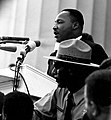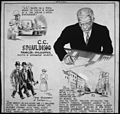Portal:Civil rights movement
The civil rights movement portal The civil rights movement was a social movement and campaign in the United States from 1954 to 1968 that aimed to abolish legalized racial segregation, discrimination, and disenfranchisement in the country, which was most commonly employed against African Americans. The movement had origins in the Reconstruction era during the late 19th century, and had modern roots in the 1940s. After years of direct actions and grassroots protests, the movement made its largest legislative and judicial gains during the 1960s. The movement's major nonviolent resistance and civil disobedience campaigns eventually secured new protections in federal law for the civil rights of all Americans. After the American Civil War and subsequent abolition of slavery in the southern states in 1865, the three Reconstruction Amendments to the United States Constitution had granted emancipation and constitutional rights of citizenship to all African Americans, the majority of whom had recently been enslaved. For a short period of time, African-American men voted and held political office, but as time went on Blacks in the South were increasingly deprived of civil rights, often under racist Jim Crow laws, and were subjected to discrimination and sustained violence by White supremacists. African Americans who moved to the North to enhance their prospects in the Great Migration also faced barriers in employment and housing. Over the following century, various efforts were made by African Americans to secure their legal and civil rights, such as the civil rights movements of 1865–1896 and of 1896–1954. The movement was characterized by nonviolent mass protests and civil disobedience following highly publicized events such as the lynching of Emmett Till in 1955. These included boycotts such as the Montgomery bus boycott, "sit-ins" in Greensboro and Nashville, a series of protests during the Birmingham campaign, and a march from Selma to Montgomery. The movement was led by Martin Luther King Jr., and press coverage of police violence against protesters with fire hoses and dogs during the Birmingham campaign increased its public support. Discrimination was often supported by courts, including by the Supreme Court in its 1896 decision Plessy v. Ferguson, which upheld the doctrine of separate but equal. At the culmination of a legal strategy pursued by African Americans, in 1954 the Supreme Court struck down the underpinnings of laws that allowed racial discrimination as unconstitutional in Brown v. Board of Education. The Warren Court made further pro-civil rights rulings in cases such as Browder v. Gayle (1956) and Loving v. Virginia (1967), banning segregation in public schools and public transport, and striking down all state laws against interracial marriage. Following the March on Washington in 1963, moderates in the movement worked with the United States Congress to achieve the passage of several significant pieces of federal legislation that authorized oversight and enforcement of civil rights laws. The Civil Rights Act of 1964 banned all discrimination based on race, color, religion, sex, and national origin, including in schools, employment, and public accommodations. The Voting Rights Act of 1965 restored and protected voting rights for minorities and authorized oversight of registration and elections in areas with historic under-representation of minority voters. The Fair Housing Act of 1968 forbade property owners from discriminating in the rental or sale of housing. (Full article...) Selected article -The Jim Crow laws were state and local laws introduced in the Southern United States in the late 19th and early 20th centuries that enforced racial segregation, "Jim Crow" being a pejorative term for an African American. The last of the Jim Crow laws were generally overturned in 1965. Formal and informal racial segregation policies were present in other areas of the United States as well, even as several states outside the South had banned discrimination in public accommodations and voting. Southern laws were enacted by white-dominated state legislatures (Redeemers) to disenfranchise and remove political and economic gains made by African Americans during the Reconstruction era. Such continuing racial segregation was also supported by the successful Lily-white movement. In practice, Jim Crow laws mandated racial segregation in all public facilities in the states of the former Confederate States of America and in some others, beginning in the 1870s. Jim Crow laws were upheld in 1896 in the case of Plessy v. Ferguson, in which the Supreme Court laid out its "separate but equal" legal doctrine concerning facilities for African Americans. Moreover, public education had essentially been segregated since its establishment in most of the South after the Civil War in 1861–1865. Companion laws excluded almost all African Americans from the vote in the South and deprived them of any representative government. Although in theory, the "equal" segregation doctrine governed public facilities and transportation too, facilities for African Americans were consistently inferior and underfunded compared to facilities for white Americans; sometimes, there were no facilities for the black community at all. Far from equality, as a body of law, Jim Crow institutionalized economic, educational, political and social disadvantages and second-class citizenship for most African Americans living in the United States. After the National Association for the Advancement of Colored People (NAACP) was founded in 1909, it became involved in a sustained public protest and campaigns against the Jim Crow laws, and the so-called "separate but equal" doctrine. (Full article...) General imagesThe following are images from various civil rights movement-related articles on Wikipedia.
Related portalsWikiProjectsSelected biography -Viola Fauver Liuzzo (née Gregg; April 11, 1925 – March 25, 1965) was an American civil rights activist in Detroit, Michigan. She was known for going to Alabama in March 1965 to support the Selma to Montgomery march for voting rights. On March 25, 1965, she was shot dead by three Ku Klux Klan members while driving activists between the cities and transportation. Also in the pursuit car was an undercover informant working for the Federal Bureau of Investigation (FBI). His role in this and other events was not revealed until 1978. To deflect attention from the FBI, its head J. Edgar Hoover made defamatory claims about Liuzzo. (Full article...) Selected image - Dr. Martin Luther King giving his "I Have a Dream" speech during the March on Washington for Jobs and Freedom in Washington, D.C., on 28 August 1963.
Did you know?
TopicsSubcategoriesThings to doAssociated WikimediaThe following Wikimedia Foundation sister projects provide more on this subject:
Discover Wikipedia using portals
|






















































